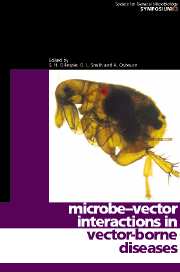Book contents
- Frontmatter
- Contents
- Contributors
- Editors' Preface
- 1 Vector-borne diseases
- 2 Evolution of tick-borne disease systems
- 3 Insect transmission of viruses
- 4 RNA-based immunity in insects
- 5 Specificity of Borrelia–tick vector relationships
- 6 Bunyavirus/mosquito interactions
- 7 How do mosquito vectors live with their viruses?
- 9 Vector competence
- 9 Environmental influences on arbovirus infections and vectors
- 10 Vector immunity
- 11 Transmission of plant viruses by nematodes
- 12 Wolbachia host–symbiont interactions
- 13 Pathogenic strategies of Anaplasma phagocytophilum, a unique bacterium that colonizes neutrophils
- 14 Interactions of Yersinia pestis with its flea vector that lead to the transmission of plague
- 15 Transgenic malaria
- 16 Vaccines targeting vectors
- Index
11 - Transmission of plant viruses by nematodes
Published online by Cambridge University Press: 06 July 2010
- Frontmatter
- Contents
- Contributors
- Editors' Preface
- 1 Vector-borne diseases
- 2 Evolution of tick-borne disease systems
- 3 Insect transmission of viruses
- 4 RNA-based immunity in insects
- 5 Specificity of Borrelia–tick vector relationships
- 6 Bunyavirus/mosquito interactions
- 7 How do mosquito vectors live with their viruses?
- 9 Vector competence
- 9 Environmental influences on arbovirus infections and vectors
- 10 Vector immunity
- 11 Transmission of plant viruses by nematodes
- 12 Wolbachia host–symbiont interactions
- 13 Pathogenic strategies of Anaplasma phagocytophilum, a unique bacterium that colonizes neutrophils
- 14 Interactions of Yersinia pestis with its flea vector that lead to the transmission of plague
- 15 Transgenic malaria
- 16 Vaccines targeting vectors
- Index
Summary
INTRODUCTION
Plant viruses use a variety of mechanisms to enable them to spread away from an initial focus of infection into the wider environment. Many viruses are able to infect the developing seed and so are disseminated to new areas when the seed is shed. In addition, viruses may be taken up, for example by insect pests and fungal pathogens as they feed on or multiply within the plant, and subsequently can be transmitted to further uninfected plants by the vector organism. It is becoming clear that rather than being a non-specific, merely passive process, transmission of plant viruses by vector organisms is a highly specific process, in which particular virus proteins are adapted to allow interaction with the vector.
Two groups of viruses, the tobraviruses and the nepoviruses, use plant-parasitic nematodes as their transmission vector (Taylor & Brown, 1997; MacFarlane et al., 2002). Nematodes are present in almost all environments both on land and in the sea and have many different lifestyles, including parasitism on animals and plants. Over 20 000 species of nematodes are known, of which perhaps 10 % are plant parasites. Considering their diversity it is perhaps surprising that, again, only two groups of nematodes, the trichodorid nematodes and the longidorid nematodes, are responsible for transmitting viruses. Plant-parasitic nematodes in their own right have a considerable impact on agriculture. Worldwide, yield losses attributed to nematode attack have been estimated at 5–12 % per year, although if nematode numbers are allowed to build up by a failure of control practices then yield loss can be far higher (Barker & Koenning, 1998).
- Type
- Chapter
- Information
- Microbe-vector Interactions in Vector-borne Diseases , pp. 263 - 286Publisher: Cambridge University PressPrint publication year: 2004
- 4
- Cited by



